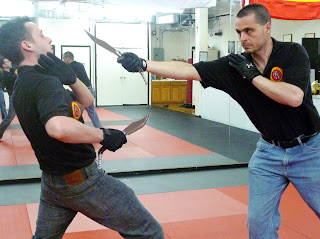 tance of never relying on just one -- or even two -- defense methods. This is known as having Redundant Defense Systems. Last weekend, during a comprehensive training workshop sponsored by the Academia della Spada in Seattle (see previous item), the few dozen participants who attended got a basic understanding of using disparate combat methodologies in a synergistic manner. (I must mention, however, that the Academia had arranged for this workshop well in advance of my writing the June 17 item.)
tance of never relying on just one -- or even two -- defense methods. This is known as having Redundant Defense Systems. Last weekend, during a comprehensive training workshop sponsored by the Academia della Spada in Seattle (see previous item), the few dozen participants who attended got a basic understanding of using disparate combat methodologies in a synergistic manner. (I must mention, however, that the Academia had arranged for this workshop well in advance of my writing the June 17 item.)As you might expect, the first training module of the workshop focused on reviewing the fundamentals of the Spanish navaja. Although the majority of participants had prior experience in this weapon, the review helped to level the playing field among beginners and "veterans."
The evening training module was for advanced members only, and we worked on removing familiar knife combat parameters in order to heighten their sensitivity to the blade's lethality. Working from an upright stance, with a low guard, and no use of the off-hand (or mano siniestra), the participants gained a personalized appreciation for the elements of distance, timing, reaction time, evasion, and attack ccmmitment.
The following day, the third training session was dedicated to French foot-fighting, However, instead of using traditional Savate, the instruction explored the rudiments of Chausson, the older street kicking art where dirty tricks are considered fair. We moved from the basic low kicks (coup de pied bas, coup de savate, coup direct) to higher body kicks, such as chasse lateral, chasse frontal, and foutte Italienne.
Continuing on to defense techniques and combinations, we integrated the knife work from the previous day by looking at methods for defeating the blade.
The afternoon's training module was centered on French cane fighting, or Canne de Combat. After a cursory review of the variety of cane systems that exist in France, we began with the standard blows codified by Maitre Maurice Sarry; brise, enleve, lateral exterieur, lateral croisse, croisse tete, croisse jambe, and others. The parries for defeating these blows, or Parades, followed. We ended the module by working combination drills intended to sharpen the eyes and the reflexes.
The final training module was, again, for advanced members. Here the participants learned the use of Le Couteau, or the application of the common knife in conjunction with Chausson foot-fighting. Physically and mentally exhausted by this point, the participants nonetheless excelled at not only picking up the basics of this unique system, but also in demonstrating their understanding of it by applying it in a realistic, albeit non-lethal, manner.
My point in describing all this is not to superficially document a weekend of trai
 ning, but to highlight the need to train in a variety of systems and show how they can be practically and tactically integrated. This provides you with a variety of skill-sets, as well as a realistic understanding of distance, how it varies according to weapon and methodology, and how controlling it can determine the outcome of an encounter. The most important lesson here is to train to fight effectively at every combat interval. You cannot have the luxury of a favorite comfort zone -- the choice of where and how you fight may not be yours to make.
ning, but to highlight the need to train in a variety of systems and show how they can be practically and tactically integrated. This provides you with a variety of skill-sets, as well as a realistic understanding of distance, how it varies according to weapon and methodology, and how controlling it can determine the outcome of an encounter. The most important lesson here is to train to fight effectively at every combat interval. You cannot have the luxury of a favorite comfort zone -- the choice of where and how you fight may not be yours to make.






